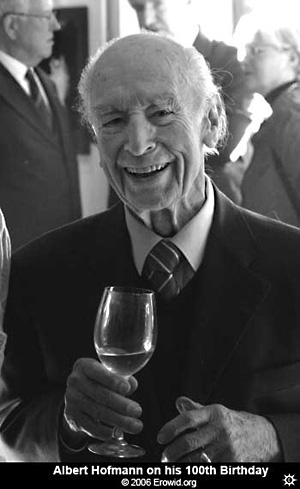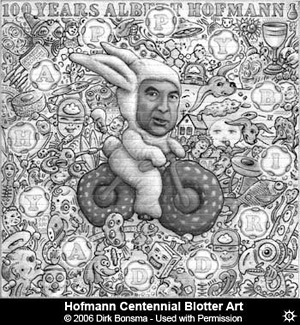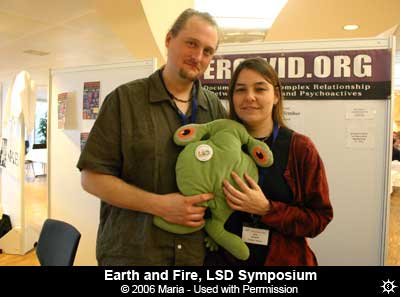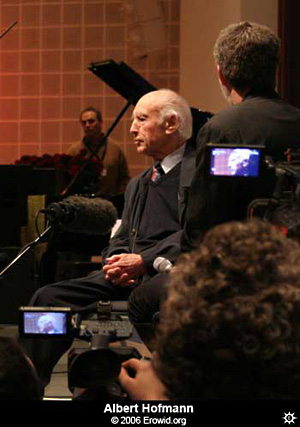The Spirit of Albert
Jun 2006
Citation: Erowid F, Erowid E. "The Spirit of Albert". Erowid Extracts. Jun 2006;10:24-25.
 Before the 2006 LSD Symposium in Basel officially started, a smaller event was held at the local Museum der Kulturen to honor Dr. Albert Hofmann, the inventor of LSD. Two hundred people gathered on January 11, 2006 to celebrate Albert's 100th birthday, and thank him for his contributions to Basel, Switzerland, and the world.
Before the 2006 LSD Symposium in Basel officially started, a smaller event was held at the local Museum der Kulturen to honor Dr. Albert Hofmann, the inventor of LSD. Two hundred people gathered on January 11, 2006 to celebrate Albert's 100th birthday, and thank him for his contributions to Basel, Switzerland, and the world.The proceedings included tributes by longtime friends, city officials and other notables. The majority of the speeches were in German, so those of us who are not German-fluent had time to soak up the dignified atmosphere of the gathering. The room--wood paneled with high ceilings and deep red walls covered with large classical portraits of staunch Swiss characters in giant neck ruffs--was overflowing with well-wishers, colleagues, and the press.
One of the two most surprising presentations was by a representative of Novartis Pharmaceuticals, the corporation that resulted from the 1996 merger between Ciba-Geigy and Sandoz, where Hofmann worked from 1929 to 1971. He gave a detailed overview of how important Dr. Hofmann's work had been to Sandoz, and how profitable his discoveries had been for them. It was unexpected that this large international corporation was willing to tie itself so closely to Dr. Hofmann's work producing and promoting LSD. The most remarkable presentation was the reading of a letter by Mr. Moritz Leuenberger, President of the Swiss Confederation, who praised Albert as a very special Swiss citizen. He wrote, "Dear Albert--you as a mystic and a scientist have more freedom of thought than we politicians will ever have…"
A local politician followed, saying, "Only a few human beings discover something that moves the world. Only a very few lucky people live to be 100 years old. This region is very proud of having one of its citizens who did both."
Although most presenters mentioned his work with LSD, they focused primarily on Albert as a human being and scientist.
A reception with wine and snacks followed the formal function in the museum. Despite walking with the assistance of crutches, Albert stood unaided for nearly two hours during the reception, pressed upon by a constant stream of people wanting to meet him, thank him, shake his hand, or seize the opportunity to have their photo taken with him. The stamina, patience and cheer with which he greeted those who sought his attention was amazing.
Myron Stolaroff introduced the two of us to Dr. Hofmann and we were thrilled when he recognized our names and thanked us for our work bringing his collection of LSD-related papers to the Internet; our excitement at his recognition made us realize that we were indeed Hofmann groupies. Albert said that his grandson had shown him the Hofmann Collection online and that he was "very, very pleased" that it was now widely available, and he was happy with how we'd handled the papers. He spoke to us in both English and German and was surprisingly sharp and lucid. We can only hope that we will be as intellectually intact if we survive as long as he has.
The Conference
 On Friday, as the Spirit of Basel symposium got underway (organized by the Gaia Media Foundation), we were once again struck by Dr. Hofmann's mental acuity; he spoke from memory, with no notes, for 30–45 minutes. Each time he presented during the weekend it was always with clarity and consistency.
On Friday, as the Spirit of Basel symposium got underway (organized by the Gaia Media Foundation), we were once again struck by Dr. Hofmann's mental acuity; he spoke from memory, with no notes, for 30–45 minutes. Each time he presented during the weekend it was always with clarity and consistency. The general mood of the conference attendees was extremely buoyant. We chatted with hundreds of people over the course of the weekend. One of the most frequent questions we were asked was whether we thought this conference represented a turning point of some kind in the cultural view or status of LSD. While that question remains to be answered in the future, people were excited by the momentous feeling of the gathering.
We spent the weekend (when we weren't scrambling to finish the slides for our presentation) pondering what about this event engaged people so effectively, even people who had been to dozens of similar conferences and were jaded to the familiar format. There is something compelling about the fact that the man who discovered LSD--who has had a 60-year relationship with the substance--still speaks eloquently about its value to humanity after having reached the remarkable age of 100 years.
Whether or not it is reasonable to extrapolate from this single data point, it seems a clear falsification of many of the direst claims about LSD's negative effects on the brain and mind.
There were more than 70 presenters speaking about a variety of topics ranging from harm reduction to scientific research to astrology, though most stuck to details about the history, chemistry, therapeutic applications and cultural impact of LSD.
There were also a large number of media representatives and reporters present. We, along with many of the presenters, were hounded repeatedly to do video and radio interviews. We decided to say yes to a number of them, something we have not often done before.
Though there is a lot more to say about our time in Basel, it was a fun trip and a great, well-organized conference.
For more stories, descriptions, photos, and audio/video clips about the Symposium, visit the 2006 LSD Symposium Main Page.




